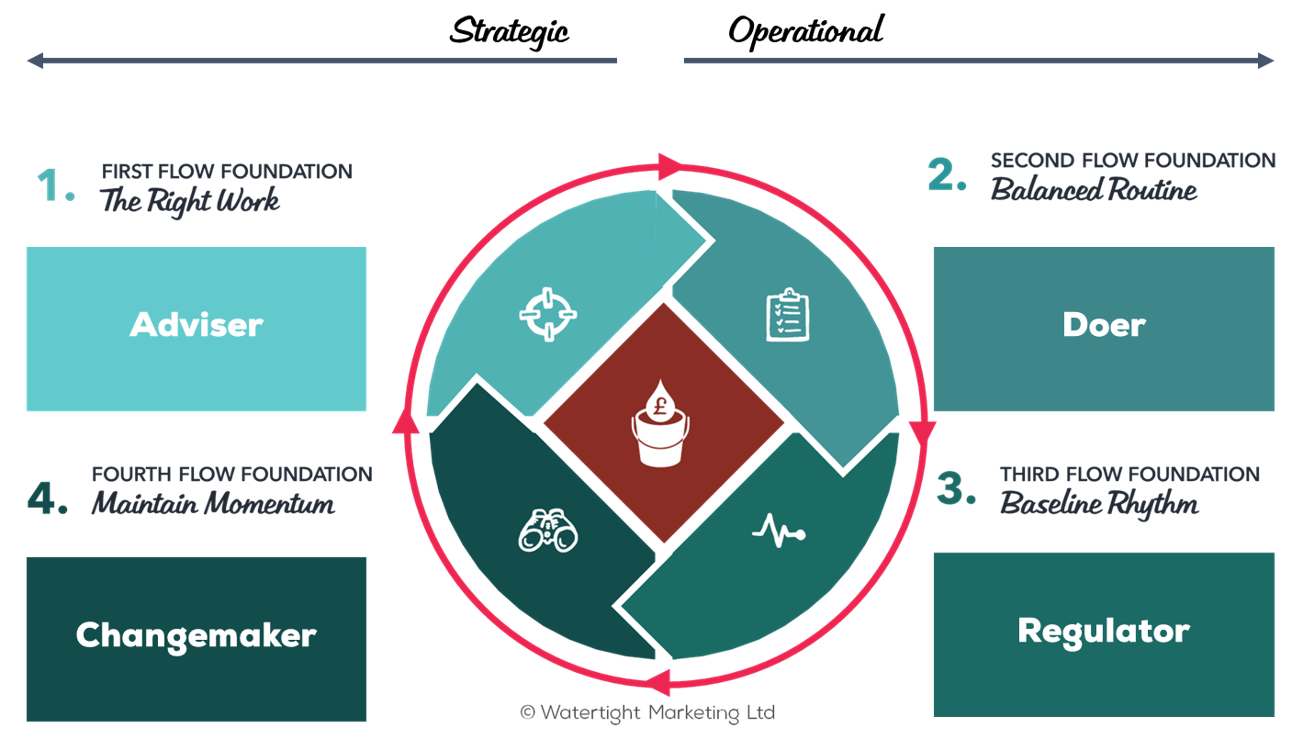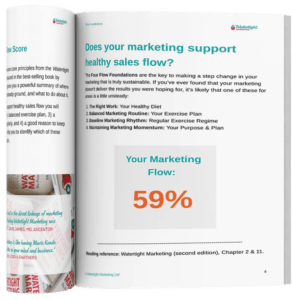Reading Time: 10 Minutes
“For those stepping into to a leadership position, what skills and knowledge do you need? What does good look like and what does the business you’re in expect of you? In this month’s roundtable we talked about what qualities you need, what the role entails and how to make sure you’re both successful and motivated.” ~ Rachael Wheatley, Managing Director | Watertight Business Thinking
Listen to the session podcast here
55-minute roundtable discussion on what makes for a good marketing leader.
Within the context of our four Foundations model, marketing leadership positions tend to be more on the strategic side. That’s not to say you can’t be a leader in your own operational area, even if you’re not on the leadership or management team. It’s not necessarily about seniority!
However, for the discussion, we focused on marketing leadership at an organisational level. There are two hats a leader would wear – adviser and changemaker.
The adviser – listens, reflects, provides opinion, insight, advice. They work consultatively and collaboratively with others and get different perspectives from around the business to help form a well-rounded view or decision.
The changemaker – is an innovator and challenges the status quo. They shake things up, have difficult conversations and innovate. They look at what needs to happen to move things forward and are happy to lead the change. They are willing to have a view, voice their opinion and back it up.

You’d see a combination of these characteristics in a marketing leader – and both roles are important. The changemaker role because a lot of marketing involves change. The adviser because you’re definitely going to be involved in getting buy-in around the business and in building relationships with every other business lead, and that’s done best with an advisory approach.
What does good marketing leadership look like?
We talked through some thought-starters to frame the discussion.
- Clear vision and plan: if it’s not there already, help the MD and leadership team create it. Then translate that into your marketing strategy and plan.
- Mindful self-enquiry: being reflective and asking questions. How can I best serve the customer, the business and my team? How does this dovetail with what is expected of me and the team? How might I need to change how I lead based on what’s happening now? What do my skills, insight, experience, perspective bring to the business and is anything missing? Answers to these questions lead to continual improvement, even if that’s incremental.
- Good peer relationships: you’ll need to develop close working relationships with all other department leads. There isn’t one other function that marketing doesn’t touch so making friends and having regular conversations with finance, HR, IT, operations, sales and customer services is crucial.
- Bird’s eye perspective: a leadership role is necessarily more strategic. Your time-horizons span the short, medium and longer-term and your perspective covers internal and external landscapes. If you’re the only marketer or in a small team, having this perspective is hard – because you will be asked to do the doing and be operational more than you will be asked to have that bird’s eye perspective. Protect your time to do this.
- Customer centredness: marketing always has the customer at its heart and we often see ourselves as their champion. However, we’re not always in direct contact with them. If that’s so, part of your role as marketing leader will be to ensure that you, and the team, have contact with, and a deep understanding of the customers’ point of view, needs and wants. Don’t forget your internal customers, too!
- See sales, marketing & service as one: for maximum effectiveness it’s important to see these teams as one; there is, after all, one journey for the customer. As marketing lead, you’ll understand the sales process, the skills involved, and that great service and loyal customers are all part of the same journey.
- The right mindset: there’s a key mindset shift needed when you taking on a leadership position for the first time. You’re often no longer involved in the doing – or at least it’s reduced involvement. You’ll deliver through your team, so your job is to equip, enable and empower them to be able to do that and bring out the very best in them.
Bryony Thomas: “I was reflecting on my own journey and think there were things that came more naturally to me – those things that were internal and within my control, such as the right mindset – and things that didn’t. I had to work hard on peer relationships, for instance. Seeing the internal customer as a key communications priority was key for me.”
Abby Dixon: “Self-awareness is important. If you want to build motivated teams and empower them with to be high performing, then you need to know what motivates them, you need to know what their skill sets are. But you can only really understand that if you know what motivates you. So get really clear on what drives, what your purpose is.
“When you move into a leadership position, make a conscious effort to think about what type of leader you want to be, about your authentic leadership style that fits with your values and is what the wider business is going to benefit from.
“People want their leaders to be inspirational. That means having a vision and dreaming big, sharing the story, which motivates people. Then translating that into goals and milestones and understanding what support is needed. Leaders also take action, they make the changes needed.”
Rachael Wheatley: “I used to think you had to be charismatic to be a successful leader, but I don’t think that’s true. You can still do it in a quieter way.”
Abby Dixon: “I see a lot of leaders who feel conflicted between who they naturally area and how they want to show up. They think because others around them are outgoing and confident, they have to be too. I think there are many ways in which you can have people bought into your vision without it being in an outgoing way.
Moving into a leadership position
Charlie Southwood: “Any advice you’d have for someone like me whose in a small company and trying to carve out a more senior, strategic role? And how much should I challenge the strategy and vision or toe the line?”
Abby Dixon: “The first thing to do is work out where the strategy is being written. In any case, be part of writing it so you’re involved in making choices about what markets to play in, what segments you’re targeting and how you’re being positioned. In doing that, you’re also sure that marketing is perceived as a strategic arm in the business and leading the commercial agenda.
“You should also own the voice the customer and ring bring it as insight. And, as the most senior marketer in the business comes the responsibility of educating others in the role of marketing in the business. Do ruffle feathers, but do so from a place of curiosity, asking questions.”
Rachael Wheatley: “I would add to that – do ruffle some feathers, but know that you have the support of your CEO. Otherwise it’s a lonely place to be. If you’re having difficult conversations, you need someone to back you up and have your back.”
Bryony Thomas: “To the point earlier, don’t forget internal customers. These are your colleagues and often you’re selling them marketing, the value of marketing. What does the FD or MD need to know about know you’re there to add value to the business? Look at good books that have interesting models– like Watertight Marketing – and get out some tools that you can use in a meeting. It demonstrates strategic thought, helps you to lead the conversation and gets people working together.”
Rachael Wheatley: “Getting involved in a strategic project is a good way of positioning yourself, too, and getting in front of, and working with, all sorts of people in the business. Coming out of the business plan will be at least one that you can lead on.”
Samantha Hill: “You need to listen to people across the organisation. I spend at least 50% of my time bringing people on the journey, but it’s always a difficult balance between listening and leading or taking action.”
Bryony Thomas: “Structured listening can be a good answer to that. You want to be creating a workshop environment where you can interrogate a topic, use a model and facilitate the conversation. Shows gaps that invites people to contribute.”
Expectations versus reality
Bryony Thomas: “Don’t forget there will be a tension between the expectations that are set on you. There are contradictions – you need to see the big picture and be all over the detail; you need to not get distracted but stay on top of trends. Looking at the four hats model (above) ask: what hat do I need to wear? Which of my skills am I bringing to the party today?”
Kerry Turney: “I’m very fortunate in my role in that my boss buys into marketing and the whole Watertight approach. Interestingly, where I’ve had push-back is actually with external partners that have questioned the marketing strategy. We have a very long sales cycle and they’ve asked me why I’m not running lead generation adverts, whereas I’m seeing the whole journey and saying we need to lead them through that journey not expect them to give us their email from one advert. Because I’ve embraced Watertight, I’ve felt confident in what I’m doing and explaining to them.”
Abby Dixon: “Again, worth coming from a place of curiosity and asking questions: why are they asking the question, what’s going on for them, why are they not aligned? You can then say you’d love to share with them why it’s part of a wider funnel and why it takes us that long.”
Bryony Thomas: “With the constant pressure to do something new or different, I’m sure there isn’t a marketing leader in the country that isn’t sitting there thinking am I missing a trick?”
Mandip Bilkhu: “As a sole marketer in a team, managing those expectations is hard. You’re trying to be strategic and operational, you’re being a photographer and graphic designer, a social media person and this and this; you’re spread thinly. I can’t even focus to refine my strategy or do a bit a competitor analysis. Hard to show leadership without junior support.”
Bryony Thomas: “You could use our four Flow Foundation model to track how much time you’re spending in each area, so when you say you need support, you can demonstrate where and why and ask whether that’s where they want you to spend your time and is that good value for money.”
Watertight Wisdom
What’s worked for us
Eight nuggets from around the room on the topic of good marketing leadership:
- Try and balance listening and leading. It’s important to listen and seek others’ views, but sometimes you need to take action.
- Create opportunities for structured listening. Run a workshop with a group of people, using a model to frame your discussion, get them to contribute.
- Use our four hats model and the four Foundations to highlight where you spend your energy. That gives you the platform to have a conversation about whether that’s the right balance, whether it gives value or if you need more resource.
- Pick the right people. Use the four hats model to understand who does what and that the right people are in the jobs.
- Look at what’s in your control. You can influence and change that much more easily.
- Dedicate time to the big picture. When you’re busy and balancing more than one hat, it’s difficult, but worth understanding that you do need to step out of the day to day and execution mode sufficiently often to ensure things are going the way you want them to.
- Get involved in creating the strategy or lead a strategic project. These are both good ways of stepping up to a leadership role.
- Don’t be afraid to ruffle some feathers but do so from a place of curiosity. Ask questions and make sure you have support from your boss; it can be a lonely place otherwise!
What would you add to our list? Do let us know your thoughts.
To join the conversation at our next Watertight Wednesday marketing roundtable in July sign up here. We’ll be having a chin-wag about how you manage internal change and change people’s thinking. We’ll be joined by a guest who has many years of experience working in change management so do come along with any questions and thoughts you have and tap into ideas from the room about how to achieve success.

Rachael Wheatley
Managing Director, Watertight Thinking
Rachael brings over 30 years’ of marketing experience, with a particular focus on building and developing effective marketing teams that are able to act as a strategic driving force across an organisation. She has worked with Watertight since 2014 as a Master Practitioner and joined the business as MD in 2022.



